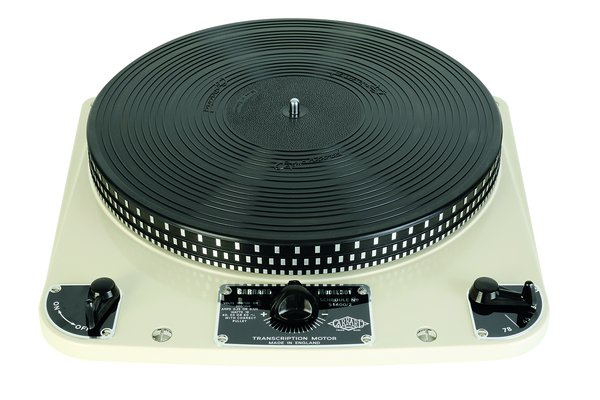Garrard 301 Advanced

I can sense your confusion. However, before you start wondering why our 'Vintage Review' has moved closer to the front of the magazine than usual, let me explain. Yes, you are looking at a turntable based around a Garrard 301, but this is a rather special one - a Garrard 301 produced in limited numbers and made strictly to order. In the plinth shown here and complete with SME Series V-12 tonearm, it will set you back £51,645, or £43,945 with an SME M2-12R. What, you might reasonably ask, is going on?
The story dates to 2018 when the Cadence Group, parent company of SME, acquired the Garrard audio brand. Previous to this, Loricraft Audio had held a licence to use the name since 1997, but the company was still owned by IGB Gradiente S.A. of Brazil, which had purchased what remained of it in 1979. The first product to bring the Garrard name back into the limelight after Cadence's buyout was the 301 Classic (or Revival) of 2019, which fitted a heavily re-worked 301 motor unit into a solid walnut plinth and added an SME M2-12R arm. The very latest turntable, seen here, bears the name 301 Advanced, and SME has taken things to another level. Think of it as the audio equivalent of a new JIA Jensen Interceptor R, or an Eagle E-Type Jaguar, and you won't be far wrong.
Three Score And Ten
Released in 1954, Garrard's 301 was effectively the first ever transcription turntable. Named after its ability to offer three speeds on one chassis it was, as designer E.W. Mortimer modestly put it, 'one of the best motors of its type obtainable. It is used by the BBC and broadcasting studios throughout the world, also by the high-fidelity enthusiast who must have the best'.
The unit comprised - and still does - a diecast aluminium baseplate supporting a shaded-pole synchronous AC induction motor spinning at 1740rpm. The motor spindle is topped by a pulley with three steps, which passes drive to a rubber idler wheel that's mechanically moved to offer 33rpm, 45rpm and 78rpm speeds. Additionally, an alloy 'eddy current brake disc' [see main pic, adjacent] is fitted to the motor shaft which, by moving a magnet around it using the speed control, allows the motor speed to be varied by ±2.5%.
The motor can be set for 100V-130V or 200V-250V operation by moving two links in a small junction box, and separate pulleys are offered to give the correct speeds for 50Hz or 60Hz mains supplies. An on/off switch both controls the electrical power to the motor and disengages the idler wheel from the pulley, so that it does not develop flat spots when not in use. A suppression capacitor is fitted across the switch and the linkage also engages a brake pad on the inner surface of the platter to bring it to a halt. The main bearing started life lubricated by grease, but this was changed to oil in the late 1950s.
The 301's idler wheel drives the inner surface of an aluminium platter. In the '50s the outer edge was plain, though three-speed versions with cast stroboscopic wedges for 50Hz or 60Hz operation were available at extra cost. Now, the outside of the platter has been re-finished and re-machined by SME to an accuracy, we're told, of 1/1000th of an inch. This isn't just for effect - variations in the outside of original platters can give the appearance of the strobe 'wavering' slightly, something I am used to on my own 1963-era 301. The strobe on the Garrard 301 Advanced is more stable than I have ever seen.

The refurbished motor unit includes
three new control plates, chromed bolts and
precision-machined strobe blocks on the platter
No Stone Unturned
The new platter finish is just the tip of the iceberg. In SME's hands, the turntable has received a complete strip-down, with the main bearing, linkage and motor springs, brake pad, suppression capacitor, wiring harness, chassis fascia plates, chassis-to-motor board mounting bolts, rubber mat [see interview boxout, right] and more all replaced with new items. Even the chassis rivets are re-created using a special mix of copper and brass, while the chassis itself has been blasted and re-painted in a new acrylic paint and the metal linkages stripped and re-plated. This is for safety as well as aesthetic reasons - Garrard's original paint was lead-based and the linkages were cadmium-plated, two materials now banned.
The retooled deck is mounted into a 563x400mm (wd) plinth made from an advanced polymer resin, the same as that featured on SME's own Model 6 turntable. This sits on four adjustable feet incorporating bespoke isolation materials and configuration. There are further layers of this isolation between the arm and plinth, and the 301 chassis and plinth - the latter can be finished in any RAL colour of your choosing, with ours being RAL 9018 (Papyrus White). This gives the whole assembly a vintage vibe similar to the ivory colourway the company introduced for the 301's second edition, when it replaced the rather industrial-looking original grey hammertone finish.
As well as the tools for the SME Series V-12 tonearm, the 301's box contains a reproduction copy of the original cloth-bound hardback manual. Some pictures have been updated but all the original fold-out mounting templates, and instructions for securing the motor unit in a wooden box with sprung top-plate, are still there. Fortunately, a note clarifies these are merely included for originality's sake!

Both the CNC-machined polymer resin
plinth and large, adjustable black alloy feet are
products of the SME design team in Steyning
New Age Music
With my Ortofon Cadenza Black MC fitted, the 301 Advanced provided a trip down memory lane. To my shame, my own Garrard 301 has been unused for several years, but I was instantly reminded of everything that I always loved about it, such as its sheer drive, power and timing. This turntable locks onto rhythms and basslines with scarcely believable precision. Low-end elements simply arrive, stun you with their impact and leave. There is no wallow, no overhang and no uncertainty. And if that bass note is a proper deep, juicy one, then you'll know about it.
And yet the 301 Advanced can be soft, subtle and beautifully restrained when the occasion demands. It can reveal everything on the record and has an impressively wide dynamic range. Sounds ranging from a very soft background effect to a huge percussive crescendo are handled with ease, the former helped by something that may be a concern to many reading about an idler drive deck... Don't worry - the 301 Advanced is as quiet as a church mouse in terms of background noise and rumble.

The supplied SME Series V-12 tonearm
is wired directly to rear-mounted, gold-plated
RCA phonos and a central earth post
Flying High
This means there is nothing untoward about its performance to spoil your listening pleasure. Allison Russell's vocals on 'Nightflyer' [Outside Child; Fantasy Records FAN01126] were as heartfelt and emotional as I can remember hearing, and the bass drum provided a solid, deep backing without ever threatening to dominate the lightly struck acoustic guitar or keyboard effects. The 301 Advanced just made sure all the parts were clear and relevant to the main action.
Russell's vocals were also brought well forward in the mix. The 301 Advanced does slightly show its age in that it doesn't spread its images as wide as more modern designs but somehow, even after spotting this, it didn't seem to matter. There is so much going on between the loudspeakers and in the capacious back-to-front depth perspective that I never felt sonically short-changed.
If you have read reviews of re-discovered Garrard 301s, you've likely seen the phrase 'veiled treble'. I long ago realised this is far more to do with the condition and the implementation of the deck rather than an innate character flaw, and the 301 Advanced proved this definitively. Thanks to the incredible work carried out on the motor unit, plus the plinth design and arm choice, this deck delivers music with a hugely satisfying top-end sparkle.
Cymbals are crisp, clean and blessed with a metallic sheen that makes them sound lifelike, and even when effects are electronically generated, they still have an unerring 'rightness' about them. As a result, the drum machine and synthesisers used by DJ/producer Frankie Knuckles on his 'The Whistle Song' 12in single [Virgin VUST 47] come at you with speed, vigour and impeccable timing. Meanwhile, the flute played throughout sounded nuanced and textured as the 301 Advanced made it obvious that it was a real instrument, and not an electronic imitation.
Armed And Ready
In fact, the word 'realism' appeared again and again in my review notes. Some of this is clearly down to the SME Series V-12 tonearm, which brings with it an exceptional level of sonic purity, detail and sheer musical insight. This does mean it can also highlight the shortcomings of any turntable on which it is securely mounted, but in Garrard's 301 Advanced set-up the two products seemed to complement each other wonderfully.
So, what we have here is a turntable combination that, with well-recorded material, sounds spellbinding. 'A Man Alone' from John Barry's soundtrack to The Ipcress File [Decca DL79124] was a revelation in this respect. This track features some of the most frenetic percussion you'll hear outside of a drumming convention, fronted by a cimbalom delivering the main melody and underpinned by a juicy double bass line. It evokes 1960s spy intrigue and a youthful Michael Caine but can descend into murky chaos if the turntable isn't up to the job. Through Garrard's 301 Advanced, the bassline remained clear and full-bodied no matter what else was going on, and the rest of Barry's instrumentation was reproduced with an authority and vigour that was almost physically dizzying.
Ultimately, the greatest compliment I can pay this 21st century restoration of Garrard's 301 is that it is one of those vinyl players that has you trawling through your record collection for hours on end. I found myself spending much longer than I had intended, wondering what a particular track or album would sound like. However, during my lengthy audition, I didn't find one selection where the answer was anything other than 'magnificent'.
Hi-Fi News Verdict
The Garrard 301 Advanced is a perfect example of classic British innovation combined with modern British engineering. The obsessive attention to detail brought to the motor unit, plus an expertly designed plinth and premium tonearm, deliver a truly formidable result. What it does well, very few decks do better. Forget that the design is now 70 years old - this is still one very relevant record player.
Sound Quality: 89%


















































